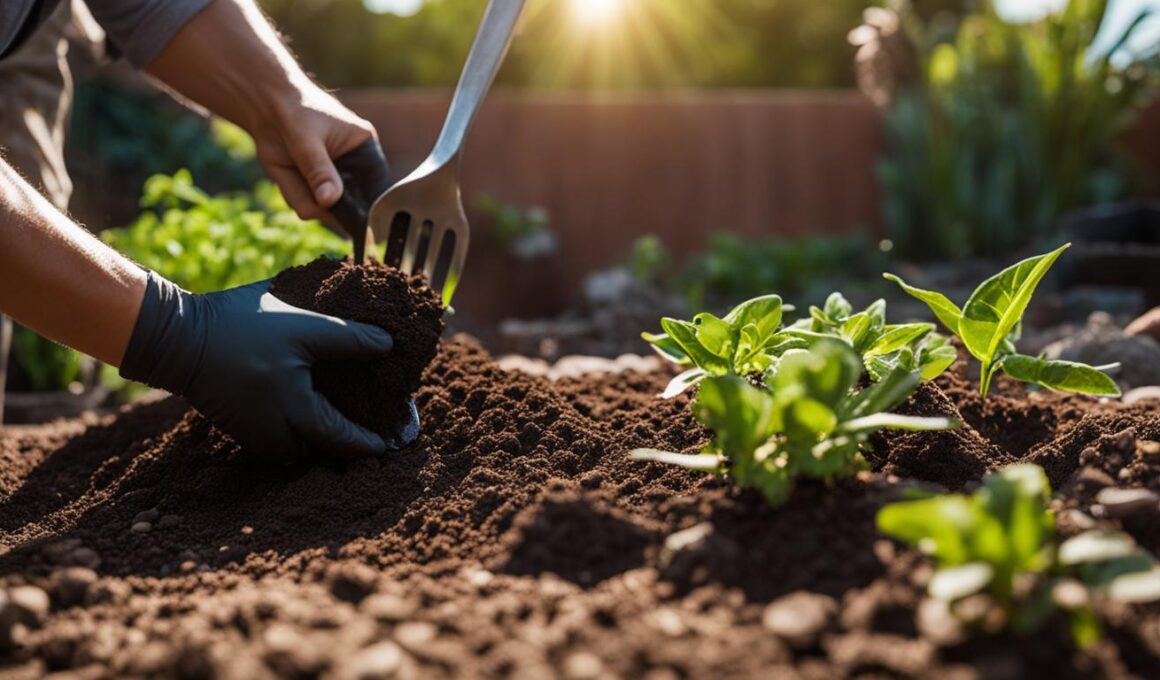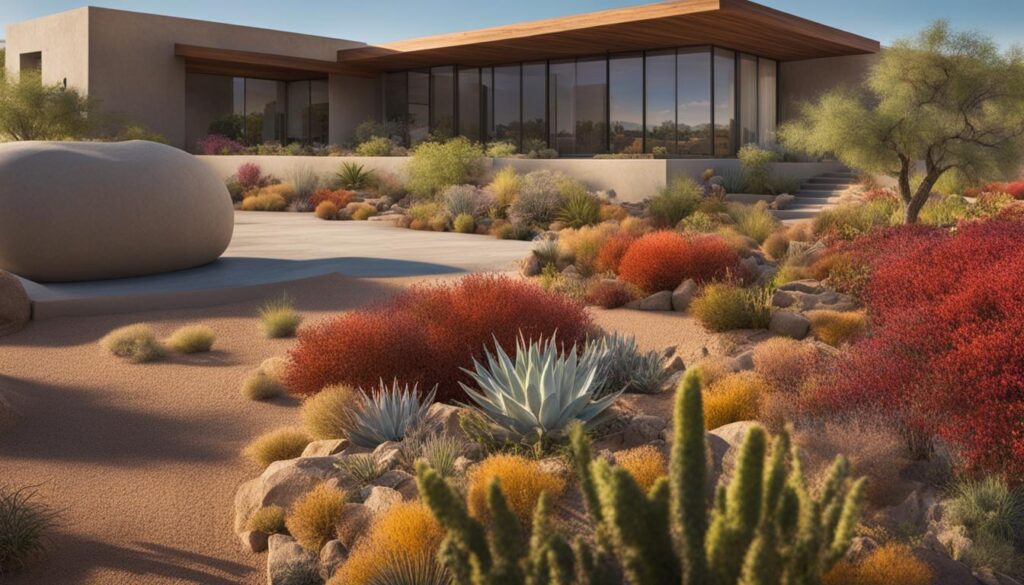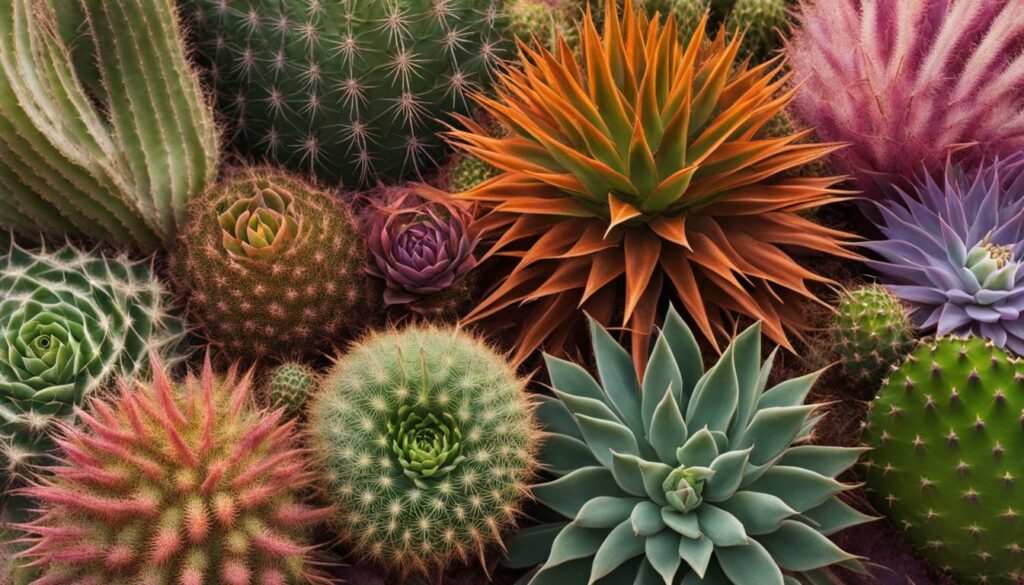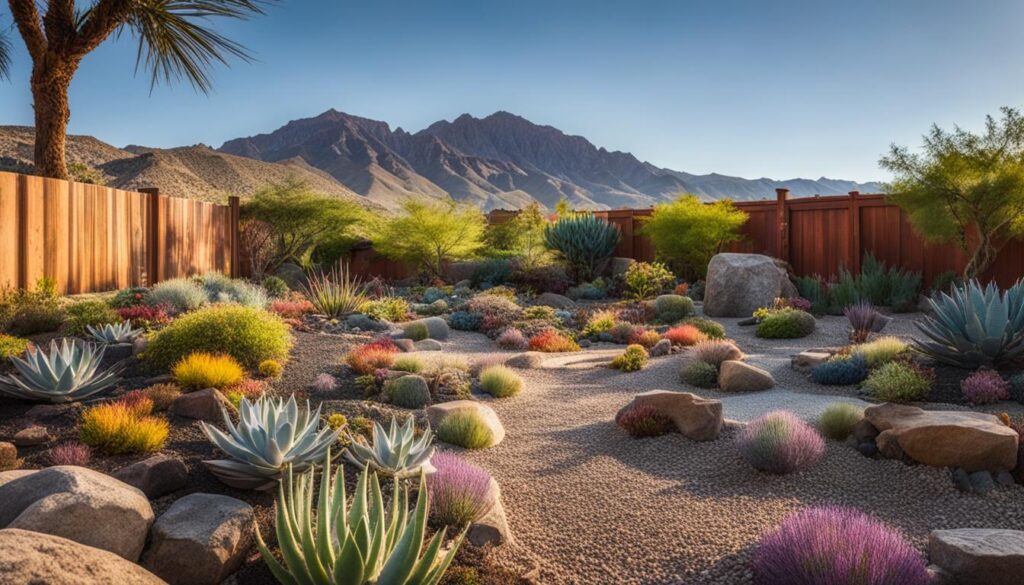Creating a stunning and sustainable xeriscape garden starts with mastering soil preparation. By understanding the importance of soil health and implementing the right techniques, you can create the perfect foundation for a thriving xeriscape garden that conserves water and supports the growth of native plants.
Key Takeaways:
- Soil preparation is crucial for the success of xeriscape gardens.
- Improving soil quality enhances water retention and nutrient availability.
- Adding organic matter, such as compost, improves soil structure and fertility.
- Testing soil pH and making necessary adjustments ensures optimal plant growth.
- Proper watering techniques help establish healthy roots and conserve water.
The Principles Behind Xeriscaping
Xeriscaping, a landscaping technique that focuses on water conservation and sustainable practices, is based on seven essential principles. By understanding and applying these principles, you can create a successful xeriscape garden that promotes water conservation, improves soil quality, and embraces the use of native plants. Let’s explore each principle in detail:
1. Water Conservation:
Water conservation is at the heart of xeriscaping. By implementing strategies like efficient irrigation systems, such as drip irrigation, and collecting rainwater, you can significantly reduce your garden’s water consumption while maintaining a thriving landscape. Conserving water not only benefits the environment but also helps lower your water bills.
2. Soil Improvement:
Improving the soil quality is crucial for xeriscape gardens. Adding organic matter, such as compost or decomposed leaves, enhances the soil’s ability to retain water, improves its structure, and promotes the growth of healthy plants. Additionally, proper soil preparation allows for better absorption of rainwater, reducing runoff and soil erosion.
3. Limited Turf Area:
In xeriscape gardening, it is advisable to minimize the use of traditional turfgrass that requires frequent watering. Instead, consider incorporating turf alternatives, such as drought-tolerant ground covers or native grasses, in your landscape design. These alternatives not only require less water but also provide diverse textures and colors, adding visual interest to your garden.
4. Use of Native Plants:
Native plants are well-suited to the local climate, making them naturally more tolerant of drought conditions and requiring less water. By incorporating native plants into your xeriscape garden, you can create an ecosystem that supports local wildlife, while also reducing the need for excessive irrigation and chemical inputs.
5. Mulching:
Mulching plays a vital role in xeriscape gardening by conserving moisture, preventing weed growth, and improving soil health. Apply a layer of organic mulch, such as wood chips or straw, around your plants to reduce evaporation, regulate soil temperature, and suppress weed growth. Mulching also adds nutrients to the soil as it decomposes.
6. Efficient Irrigation:
Efficient irrigation is a key principle of xeriscaping. Drip irrigation systems, which deliver water directly to the plant’s root zone, minimize water loss through evaporation and ensure efficient water usage. Utilizing water pressure regulators and smart irrigation controllers further optimize water distribution and prevent overwatering.
7. Low Maintenance:
Xeriscape gardens are designed to be low maintenance, requiring minimal effort to maintain their beauty. Strategies such as proper weed control through mulching, regular pruning, and appropriate turf care help reduce the need for excessive manual labor. This allows you to spend more time enjoying your garden rather than constantly maintaining it.
By implementing these principles, you can create a stunning xeriscape garden that thrives in dry climates, conserves water, and contributes to a sustainable and eco-friendly landscape.
Water Conservation in Xeriscape Gardening
Water conservation is a crucial aspect of xeriscape gardening. By implementing strategies to reduce water consumption, you can create a sustainable and environmentally friendly garden that thrives even in dry climates. One key way to conserve water is by selecting drought-resistant plants that are well-suited to your region.
These plants have adapted to survive with limited water resources, making them the ideal choice for xeriscape gardens. Some popular drought-resistant plant options include succulents, lavender, and native grasses. By incorporating these plants into your garden, you can significantly reduce the amount of water needed for irrigation.
Another effective water conservation technique is the use of efficient irrigation systems such as drip irrigation. This method delivers water directly to the plant’s root zone, minimizing water loss through evaporation. Additionally, collecting rainwater in barrels or utilizing greywater for irrigation can further reduce the reliance on freshwater sources.
In summary, water conservation is a key principle in xeriscape gardening. By selecting drought-resistant plants, using efficient irrigation systems, and implementing water-saving techniques, you can create a beautiful and sustainable garden while significantly reducing water consumption.
Benefits of Water Conservation in Xeriscape Gardening
Conserving water in your xeriscape garden not only helps to preserve this precious resource but also offers several additional benefits:
- Environmental sustainability: By reducing water usage, you contribute to the conservation of local water sources and support the overall health of ecosystems.
- Cost savings: Water conservation can lead to decreased water bills, especially in areas where water is scarce or expensive.
- Reduced maintenance: Drought-resistant plants require less watering and maintenance compared to traditional gardens, saving you time and effort.
- Enhanced plant health: Drought-resistant plants are adapted to thrive in arid conditions, resulting in healthier and more resilient plants in your garden.
Incorporating water conservation practices into your xeriscape garden not only benefits the environment but also offers practical advantages for both you and your garden. By making conscious choices and implementing efficient irrigation systems, you can create a sustainable and beautiful outdoor space.
Soil Improvement for Xeriscape Gardens
When it comes to creating a successful xeriscape garden, soil improvement is a key factor to consider. By enhancing the soil structure and increasing its ability to retain water, you can ensure the optimal growth and health of your plants. One effective way to improve soil quality is by incorporating organic matter.
The addition of organic matter, such as compost or well-rotted manure, helps to enrich the soil with essential nutrients and microorganisms. This, in turn, promotes healthy root development and enhances the overall fertility of the soil. Organic matter also plays a crucial role in improving soil structure.
By incorporating organic matter, the soil becomes looser and more porous, allowing for better air circulation and water drainage. This helps prevent waterlogging and reduces the risk of root rot. Additionally, the improved soil structure makes it easier for plant roots to penetrate the soil, allowing them to access water and nutrients more efficiently.
When adding organic matter to your xeriscape garden, aim for a depth of 2-4 inches. Spread the organic matter evenly over the soil surface and gently mix it in using a garden fork or tiller. This will ensure that the organic matter is well-distributed throughout the root zone, providing maximum benefits to your plants.
Benefits of Soil Improvement:
- Enhanced water retention
- Improved nutrient availability
- Optimal root development
- Better soil structure
- Reduced risk of waterlogging and root rot
Table: Comparison of Soil Types
| Soil Type | Water Retention | Nutrient Availability | Root Penetration |
|---|---|---|---|
| Clay Soil | High | High | Difficult |
| Sandy Soil | Low | Low | Easy |
| Improved Soil | Moderate to High | Moderate to High | Easy |
“Improving the soil in your xeriscape garden is essential for creating a thriving and sustainable landscape. By incorporating organic matter, you can significantly enhance water retention, nutrient availability, and root penetration. This will ultimately lead to healthier and more resilient plants.”
By considering the importance of soil improvement in xeriscape gardening, you are taking a proactive step towards creating a water-efficient and environmentally friendly garden. Investing time and effort in enhancing the soil structure and adding organic matter will pay off in the long run, as your plants will thrive and require less water and maintenance.
Limited Turf Area in Xeriscape Gardening
In xeriscape gardening, it is important to limit the amount of turf area in your garden to conserve water and promote sustainability. Traditional grass lawns require significant amounts of water to maintain their lush appearance, making them a less environmentally friendly choice in dry climates.
Instead of opting for a large turf area, consider incorporating turf alternatives that require less water and maintenance. Ground covers, such as creeping thyme or clover, can provide a lush carpet-like appearance while requiring minimal watering. These alternatives not only conserve water but also reduce the need for frequent mowing and fertilization.
Native grasses are another excellent choice for limited turf areas in xeriscape gardens. These grasses are adapted to the local climate and require less water to thrive, making them ideal for water-efficient landscaping. Additionally, native grasses contribute to soil health, prevent soil erosion, and provide habitat for local wildlife.
By reducing the amount of turf area in your xeriscape garden and exploring turf alternatives, you can create a stunning and sustainable landscape that conserves water while still maintaining a beautiful appearance.
Table: Turf Alternatives for Xeriscape Gardens
| Turf Alternative | Water Requirements | Maintenance Level |
|---|---|---|
| Creeping Thyme | Low | Low |
| Creeping Juniper | Low | Low |
| Clover | Low | Low |
| Buffalo Grass | Low to Moderate | Low |
| Blue Grama Grass | Low to Moderate | Low |
Use of Native Plants in Xeriscape Gardens
One of the key principles of xeriscape gardening is the use of native plants. Native plants are well-adapted to the local climate and soil conditions, making them more resilient to drought and requiring less water. They have evolved over time to withstand the challenges of the region, making them an excellent choice for xeriscape gardens.
The use of native plants also contributes to the ecological health of the area. These plants provide habitat and food sources for local wildlife, including bees, butterflies, and birds. By incorporating native plants into your xeriscape garden, you can help support biodiversity and create a more sustainable ecosystem.
When selecting native plants for your xeriscape garden, it is important to consider regional suitability. Different regions have different native plant species, so it’s essential to choose plants that are native to your specific area. Native plant nurseries and local gardening resources can provide valuable guidance and recommendations based on your location.
Benefits of Using Native Plants in Xeriscape Gardens
There are several benefits to using native plants in xeriscape gardens:
- Water efficiency: Native plants have adapted to local conditions and require minimal watering once established. They have deep root systems that can access moisture deep within the soil.
- Drought resistance: Native plants are naturally adapted to survive in drought conditions, making them an ideal choice for xeriscape gardens.
- Low maintenance: Once established, native plants require less maintenance compared to non-native plants. They are well-suited to the local climate and soil, reducing the need for fertilizers and pesticides.
- Wildlife habitat: Native plants provide food and shelter for local wildlife, supporting a diverse range of species.
By incorporating native plants into your xeriscape garden, you can create a beautiful and sustainable landscape that thrives with less water and maintenance. It’s an environmentally friendly choice that benefits both your garden and the local ecosystem.
| Native Plant | Region | Water Requirements |
|---|---|---|
| California Poppy | California | Low |
| Prickly Pear Cactus | Texas | Very low |
| Black-Eyed Susan | Mid-Atlantic | Medium |
| Blue Flax | Great Plains | Low |
Using native plants in xeriscape gardens not only conserves water but also creates a sense of place. These plants reflect the unique character of the region and contribute to the overall beauty and sustainability of the landscape.
Mulching in Xeriscape Gardening
Mulching is a crucial practice in xeriscape gardening that offers numerous benefits for moisture retention and weed prevention. By adding a layer of organic mulch to your garden beds, you can create a protective barrier that helps retain moisture in the soil, reducing the need for frequent watering. This is particularly important in xeriscape gardens, where water conservation is a top priority.
Organic mulch, such as wood chips or compost, not only helps retain moisture but also insulates the soil, keeping it cooler during hot weather and warmer during colder periods. This helps create a more stable environment for plant roots, promoting healthy growth and resilience. Additionally, mulch acts as a natural weed barrier, suppressing the growth of unwanted plants and reducing the need for manual weeding.
“Mulching is a simple yet effective technique for conserving moisture and preventing weed growth in xeriscape gardens.”
The Benefits of Mulching in Xeriscape Gardening
Here are some key benefits of mulching in xeriscape gardening:
- Moisture retention: Mulch acts as a protective layer that reduces evaporation, allowing the soil to retain moisture for longer periods. This helps conserve water and creates a more favorable environment for plants.
- Weed prevention: Mulch helps suppress the growth of weeds by blocking sunlight, preventing weed seeds from germinating and competing with your desired plants for resources.
- Soil temperature regulation: Mulch insulates the soil, keeping it cooler during hot weather and warmer during colder periods. This helps create a more stable environment for plant roots, protecting them from extreme temperatures.
- Organic matter enrichment: As the mulch breaks down over time, it adds organic matter to the soil, improving its structure and fertility. This provides essential nutrients for plants and encourages beneficial soil organisms.
| Types of Mulch | Pros | Cons |
|---|---|---|
| Wood chips | Slowly decomposes, provides long-lasting mulch, helps protect soil from erosion | May attract termites if piled against the house, requires regular replenishment |
| Compost | Improves soil structure, adds nutrients, supports beneficial soil organisms | May dry out quickly, requires regular replenishment |
| Straw | Cost-effective, helps retain moisture, lightweight | May contain weed seeds, can blow away in windy conditions |
When selecting mulch for your xeriscape garden, consider the specific needs of your plants and the local climate. Different types of mulch have varying levels of moisture retention, durability, and aesthetic appeal. It’s also important to apply mulch correctly, ensuring a depth of 2-4 inches and leaving space around plant stems to prevent moisture-related issues.
By implementing mulching techniques in your xeriscape garden, you can conserve water, reduce weed growth, and create a more favorable environment for your plants. It’s an easy and effective way to enhance the beauty and sustainability of your garden while minimizing maintenance requirements.
Efficient Irrigation in Xeriscape Gardens
Efficient irrigation is a vital component of xeriscape gardening, ensuring that your plants receive the necessary water while minimizing waste. By implementing proper irrigation techniques, such as drip irrigation, you can maximize water conservation and promote the health and growth of your xeriscape garden.
Drip irrigation is a highly efficient method that delivers water directly to the plant’s roots, reducing evaporation and water runoff. This irrigation system uses a network of tubes with small emitters that release water slowly and consistently, allowing plants to absorb water more effectively. It is particularly beneficial in xeriscape gardens as it reduces water loss and minimizes weed growth.
To further optimize water usage, consider using a water pressure regulator. This device helps maintain a steady and controlled water flow, preventing overwatering and ensuring that plants receive the right amount of water they need. It also helps conserve water by preventing water waste due to excessive pressure in the irrigation system.
Incorporating efficient irrigation practices, such as drip irrigation and water pressure regulation, not only conserves water but also contributes to the overall sustainability and success of your xeriscape garden. By minimizing water usage and maximizing water absorption, you can create a thriving and environmentally friendly landscape.
Low Maintenance in Xeriscape Gardening
One of the major advantages of xeriscape gardening is its low maintenance nature. With proper planning and care, you can create a beautiful and sustainable garden that requires minimal effort to upkeep. By implementing effective weed control strategies, ensuring proper turf care, and adopting smart gardening practices, you can enjoy a thriving xeriscape garden without the need for constant maintenance.
Weed Control
Weeds can be a nuisance in any garden, but in xeriscape gardens, they can compete with native plants for water and nutrients. To keep weeds at bay, employ mulching techniques to suppress their growth and maintain soil moisture. Apply a layer of organic mulch, such as wood chips or compost, around plants and in open spaces to create a barrier against weed seeds. Regularly inspect your garden for any emerging weeds and remove them promptly to prevent them from spreading.
Proper Turf Care
If you have a limited turf area in your xeriscape garden, it’s essential to take good care of it. Proper turf care includes mowing at the correct height to encourage deep root growth and reduce water evaporation. Avoid over-fertilization, as excessive nutrients can lead to increased water requirements and maintenance. Regularly aerate the soil to improve its overall health and drainage, allowing water to penetrate more efficiently.
| Low Maintenance Tips for Xeriscape Gardens | Benefits |
|---|---|
| Choose native plants adapted to your region | Require less water and maintenance |
| Incorporate ground covers and mulch | Suppress weed growth and retain moisture |
| Use drip irrigation or soaker hoses | Target root zones and minimize water loss |
| Install a water-efficient irrigation system | Control water usage and prevent overwatering |
| Group plants with similar water needs | Optimize watering and minimize maintenance |
“A well-designed xeriscape garden can significantly reduce the time and effort required for maintenance, allowing you to spend more time enjoying your outdoor space.”
Incorporating these low maintenance tips can help you create a xeriscape garden that thrives with minimal effort. By selecting native plants, using effective weed control techniques, and practicing proper turf care, you can enjoy a beautiful and sustainable garden that enhances the overall appeal of your outdoor living space.
Is the Soil Preparation for Xeriscape Gardens Similar to the Soil Preparation for Cacti?
Yes, the soil preparation for xeriscape gardens is similar to the ideal soil for cacti. Both require well-draining soil with low organic matter to prevent water retention. Adding sand and gravel helps with aeration and drainage, creating an environment suitable for xerophytic plants like cacti.
Conclusion
Xeriscape gardening is not only a practical solution for conserving water but also a sustainable approach to landscaping. By implementing the principles of water conservation, soil improvement, limited turf area, native plant use, mulching, efficient irrigation, and low maintenance, you can create a beautiful and environmentally friendly garden.
By embracing xeriscape gardening, you contribute to the preservation of water resources and reduce your environmental impact. This landscaping technique allows you to create a lush and vibrant outdoor space while minimizing your water consumption.
With xeriscape gardening, you can have a thriving garden that requires fewer resources and less maintenance. By choosing native plants, using efficient irrigation systems, and implementing proper maintenance practices, you can enjoy a sustainable and low-maintenance landscape.
So, whether you live in a dry climate or simply want to create a more water-efficient garden, xeriscape gardening is the way to go. By following these principles and incorporating them into your landscaping plans, you can create a beautiful and sustainable outdoor space that will be enjoyed for years to come.














